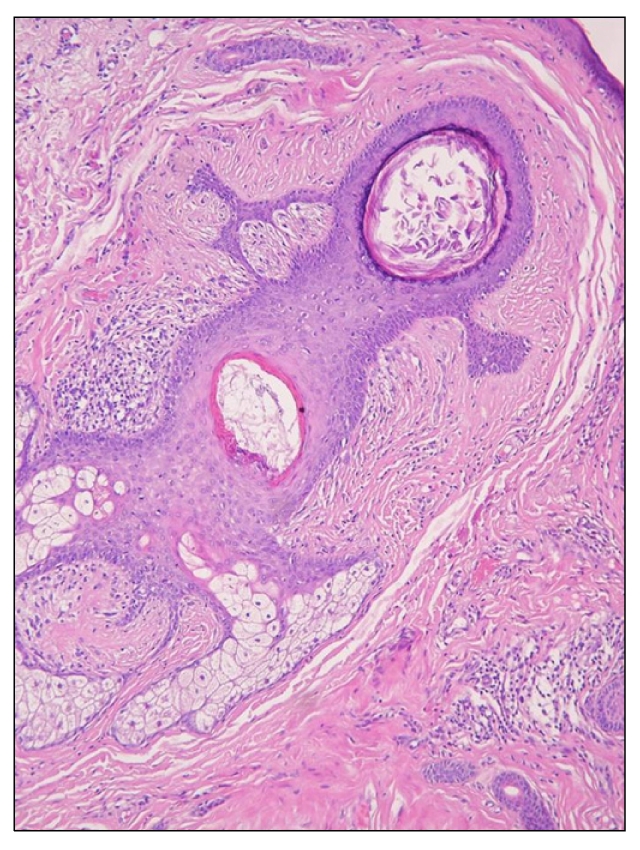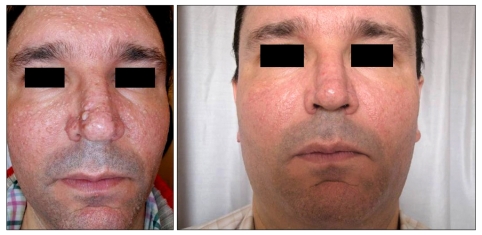Dear Editor:
Birt-Hogg-Dubé syndrome (BHDS) is an unusual genodermatosis related to systemic diseases such as recurrent pneumothorax, lung cysts and several malignancies like renal carcinoma1. Therefore, knowledge of and accurate management of BHDS can be of great benefit for the patient. The development of multiple benign adnexal tumors on visible areas can have an important psychological effect. We report 2 cases of BHDS treated successfully with a CO2 laser.
Case #1 was a 41-year-old healthy man presenting with multiple firm skin-colour papules on the face, ears and neck since adolescence (Fig. 1, image on the left). His father had the same type of lesions in higher number and one episode of pneumothorax 20 years ago.
Fig. 1.
Pictures of case #1 before and after CO2 laser treatment showing improvement of the multiple facial papules without adverse events.
Case #2 was a 54-year-old healthy man who developed, since the age of 20, multiple firm skin-colour papules on face, upper back and ears. No other family members were affected.
Histological studies were consistent with fibrofolliculomas (FF) and angiofibromas (Fig. 2). A complete blood count, biochemical studies, tumor markers and thyroid hormones showed no alterations. A thorax computed tomography (CT) showed numerous subpleural cystic lesions in case #1 and was normal in case #2. Renal echography and abdomino-pelvic CT scans were normal.
Fig. 2.

Micrograph image. Hematoxylin and eosin staining reveals classical fibrofolliculoma epithelial strands arising from the infundibulum within a mucinous connective tissue in two lesions and angiofibroma in another one (×10).
According to the literature, diagnosis of BHDS is done with more than 10 skin lesions that are clinically compatible with FF and a minimum of 1 lesion histologically diagnosed as an FF. These two cases were therefore diagnosed as BHDS2,3. They received one CO2 continuous wave laser treatment (2 watts, vaporization defocused. Sharplan 1060; Laser Industries Ltd. Tel Aviv, Israel). Topical anesthetics with lidocaine 25 mg+prilocaine 25 mg (EMLAR cream AstraZéneca) were used under 2 hours of occlusion. Substantial remission (over 75% of the facial lesions) was achieved in both cases and was maintained after 18 months of follow-up in case 1 and 4 years in case 2. There was no recurrence during this time (Fig. 1).
BHDS is characterized by asymptomatic, firm, skin-colored papules on the face and upper trunk, usually beginning in the third decade. Ear location is rather specific in BHDS2. The classical triad included FF, trichodiscomas and acrochordons. However, controversy exists in the literature about the real identity of these tumors. Currently the most accepted theory is that they actually represent a unique entity: FF4. Molecular analysis of the folliculin gene mutation supports the diagnosis. Inactivation of a tumor-suppressor gene could explain the possible coexistence with chorioretinopathy and other skin tumors such as angiofibromas, lipomas, angiolipomas, oral polyps and collagenomas2, associations that have not always been found3. Knowledge of BHDS is extremely important due to its association with recurrent pneumothorax, pulmonary cysts and malignancies (especially renal and thyroid carcinomas). Controversy exists about the possibility of an association with gastrointestinal tumors)2,5. Patients and close-relatives must be screened with abdomino-pelvic CT scanning at the time of diagnosis and with subsequent annual magnetic resonance images. Chest radiography, blood and biochemical tests, tumor markers and thyroid hormones complete the work-up1.
Differential diagnosis of these mixed ectodermal and mesenchymal origin FFs of BHDS must include other inherited syndromes with multiple firm facial papules. Those with epithelial lesions include: Cowden disease (trichilemmomas); Brooke-Spiegler syndrome and Rombo syndrome (trichoepitheliomas) and basaloid follicular hamartoma syndrome (basaloid follicular hamartoma). Angiofibromas (mesenchymal origin) [[should suggest?]] tuberous sclerosis although they have been reported in association with BHDS as well.
Classical treatment options are excision, electrocautery, and dermabrasion. Nowadays, ablative lasers represent an interesting and secure choice allowing a fast and more effective result with fewer side effects. Few cases of BHDS FF treated with lasers have been reported. Er:YAG, copper Vapor laser and CO2 lasers have been used without adverse effects6-8. Head to head studies comparing different kinds of lasers or other ablative methods are lacking.
In conclusion, we present 2 cases of BHDS treated with a low dose CO2 laser with excellent response without collateral effects. We review the required complementary studies that should be carried out.
References
- 1.Menko FH, van Steensel MA, Giraud S, Friis-Hansen L, Richard S, Ungari S, et al. European BHD Consortium. Birt-Hogg-Dubé syndrome: diagnosis and management. Lancet Oncol. 2009;10:1199–1206. doi: 10.1016/S1470-2045(09)70188-3. [DOI] [PubMed] [Google Scholar]
- 2.Vincent A, Farley M, Chan E, James W. Birt-Hogg-Dubé syndrome: a review of the literature and the differential diagnosis of firm facial papules. J Am Acad Dermatol. 2003;49:698–705. doi: 10.1067/s0190-9622(03)01582-2. [DOI] [PubMed] [Google Scholar]
- 3.Kluger N, Giraud S, Coupier I, Avril MF, Dereure O, Guillot B, et al. Birt-Hogg-Dubé syndrome: clinical and genetic studies of 10 French families. Br J Dermatol. 2010;162:527–537. doi: 10.1111/j.1365-2133.2009.09517.x. [DOI] [PubMed] [Google Scholar]
- 4.Schulz T, Hartschuh W. Birt-Hogg-Dube syndrome and Hornstein-Knickenberg syndrome are the same. Different sectioning technique as the cause of different histology. J Cutan Pathol. 1999;26:55–61. doi: 10.1111/j.1600-0560.1999.tb01792.x. [DOI] [PubMed] [Google Scholar]
- 5.Zbar B, Alvord WG, Glenn G, Turner M, Pavlovich CP, Schmidt L, et al. Risk of renal and colonic neoplasms and spontaneous pneumothorax in the Birt-Hogg-Dubé syndrome. Cancer Epidemiol Biomarkers Prev. 2002;11:393–400. [PubMed] [Google Scholar]
- 6.Kahle B, Hellwig S, Schulz T. Multiple mantleomas in Birt-Hogg-Dube syndrome: successful therapy with CO2 laser. Hautarzt. 2001;52:43–46. doi: 10.1007/s001050051260. [DOI] [PubMed] [Google Scholar]
- 7.Jacob CI, Dover JS. Birt-Hogg-Dube syndrome: treatment of cutaneous manifestations with laser skin resurfacing. Arch Dermatol. 2001;137:98–99. [PubMed] [Google Scholar]
- 8.Giroux JM, Cadotte M, Barolet D, Provost N. Fibrofolliculoma. Treatment with copper vapor laser. Ann Dermatol Venereol. 1994;121:130–133. [PubMed] [Google Scholar]



